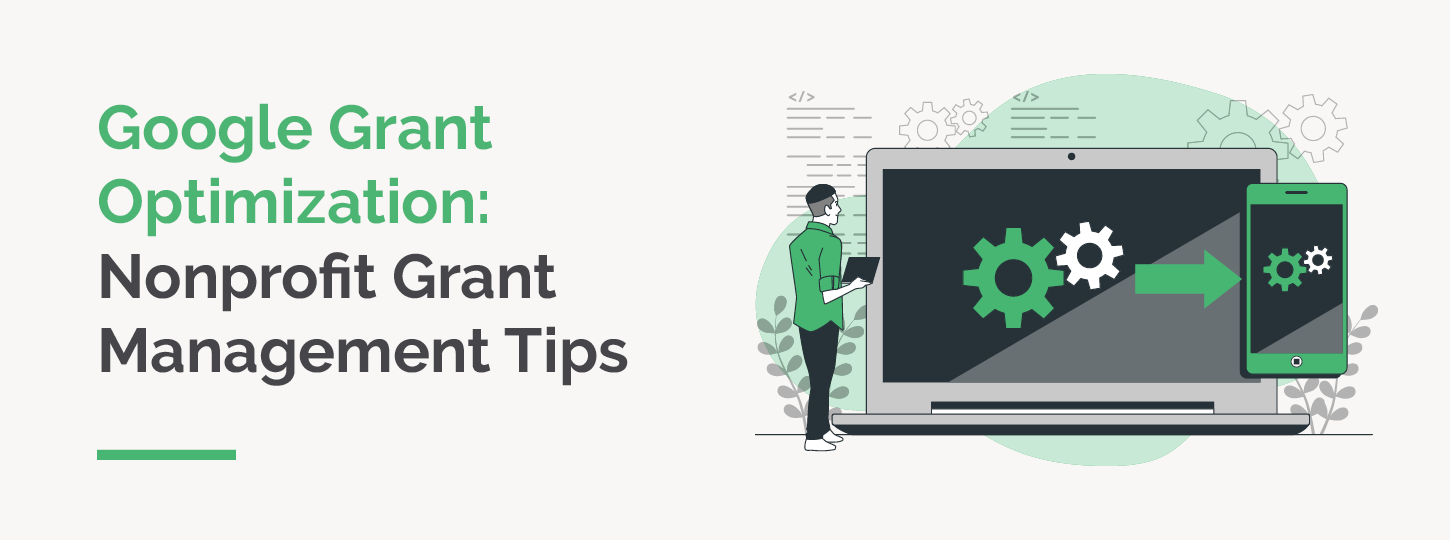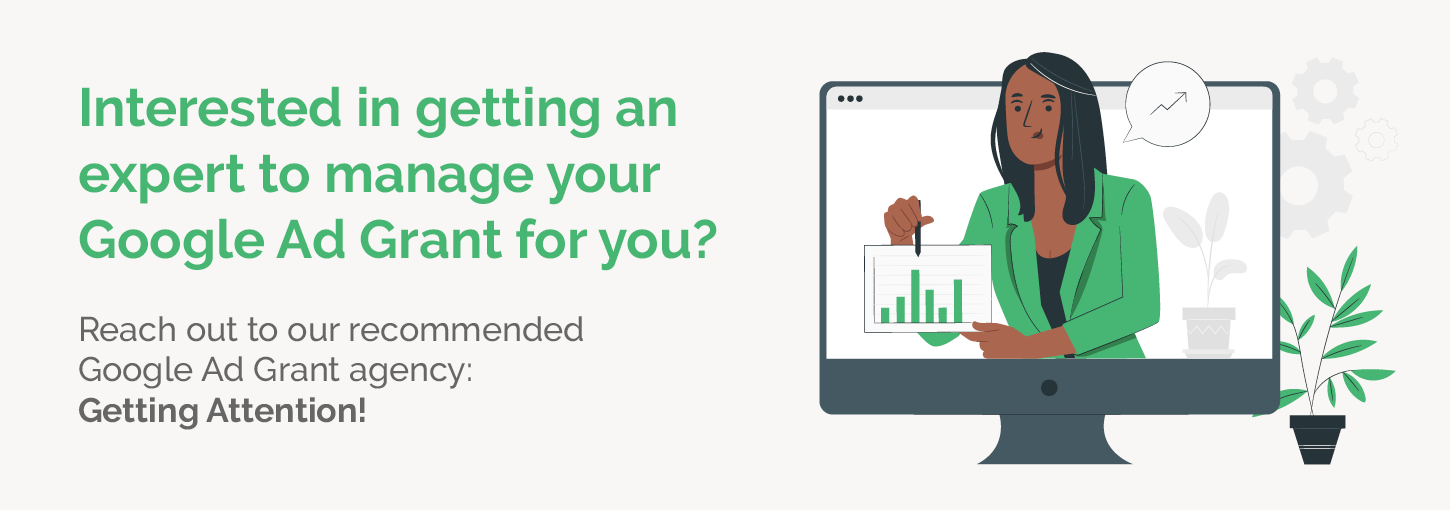Google Grant Optimization: Nonprofit Grant Management Tips
Organizations with effective nonprofit marketing strategies utilize many tools to reach their audiences. From email blasts to social media posts, these organizations leverage numerous platforms to communicate valuable information. Among all these platforms, one source of truth remains constant—your nonprofit’s website. Whether you’re promoting matching gifts or an upcoming fundraising event, most communications point back to your nonprofit’s website for more information.
If your nonprofit takes advantage of the $10,000 Ad Grant from Google, you’re taking the right steps to promote your site and your organization’s most valuable information. However, the Google Ad Grant program isn’t a single-step process.
Nonprofits are not only required to maintain their eligibility for the Google Ad Grant but also must optimize their ads and accounts to drive real results from the program. In this guide, we’ll show you how to optimize your Google Grant by covering the following topics:
- What is Google Grant optimization?
- How to manage your nonprofit’s Google Ad Grant compliance
- How to gauge your nonprofit’s campaign performance
- How to optimize your nonprofit’s Google Grant account ads
- Conclusion and additional resources
Truly making the most of this grant means managing it on a regular basis. When you do, you’ll expand your outreach as you increase website traffic and consistently appeal to new internet searchers. Understand what it means to optimize your Google Grant so you can develop a strategy that will effectively reach a large audience of potential supporters.
What is Google Grant optimization?
Google Grant optimization means managing your nonprofit’s Google Ad Grant account and the advertisements you’ve created to ensure everything stays compliant with Google’s management policies and relevant to users’ search intents. Although you can optimize almost any aspect of your Google Ad Grant participation, some common areas for improvement include:
- Keyword specificity: Ensure your ads target specific keywords (preferably long-tail, non-competitive terms). Look for opportunities to refine your keyword choices so that they’re more relevant to your organization’s current operations or goals. For example, an increase in the kitten population during the spring months might prompt an animal shelter to target keywords such as “spring kitten adoptions.”
- Data organization: In order to keep keywords relevant to your cause, your nonprofit will have to keep hygienic keyword data. This means regularly checking the quality and relevance of your keywords so that you can adjust any keywords that aren’t performing well. An animal shelter might remove the keyword “pet adoptions as Christmas gifts” in February when it becomes irrelevant to the ad’s landing page. To determine when a keyword becomes outdated or nonvaluable, nonprofits should track keyword metrics, such as click-through rate (CTR), to understand how the keyword is performing.
- Website improvements: Ensure that your website is relevant to the advertisement and provides a positive user experience for searchers who click on your ad. For starters, you can check to make sure the page is branded to your nonprofit, provides valuable information for the user, and includes the keyword targeted in the ad. Don’t stop at your landing page, though; ensure your website as a whole is valuable and easy to use for its visitors.
- Account structure: Google’s guidelines for the way you use your Google Ad Grants account require nonprofits to maintain an orderly account structure. For example, you must include more than one ad per ad group and at least two ad groups per campaign. If your nonprofit doesn’t already follow this structure, you’re not only at risk of account deactivation but also missing out on valuable keyword insight.
These aspects of your Google Ad Grant participation are just a few elements that need regular maintenance. Remember, there are countless opportunities for optimization, and it’s a crucial part of leveraging Google Ads for your nonprofit’s outreach efforts. Both the account itself and the ads you create must be refreshed to meet your audience’s needs.
It’s natural for this to seem overwhelming—after all, the Google Ad Grant is free marketing funding. Shouldn’t it make nonprofit marketing easier? If you didn’t want a Google Ad Grant agency’s help during the application process, this is where their services can be especially helpful. They’ll manage your account so that all optimization tasks are completely handled while your nonprofit’s leaders focus on fulfilling your mission.
How to manage your nonprofit’s Google Ad Grant compliance
To break down optimization even further, it can be approached in two stages: account compliance and ad updates. Start with your account—make sure you’re in compliance with all the Google Ad Grant requirements. After all, optimized ads will be no good if your account is suspended!
The list of requirements is long, but there are a few crucial ones that your nonprofit should keep in mind:
- Maintain regular activity within your account.
- Make sure your ads are specifically targeted and relevant to your nonprofit.
- Conduct monthly keyword research and optimize your list where necessary.
- Maintain a minimum of a 5% click-through rate (CTR).
- Track and report conversions and CTR.
Since your ads will lead users to your nonprofit’s website, Google also has specific website guidelines, including:
- Your nonprofit must own the domain.
- You must add any additional domains that your nonprofit owns to your Google Grants account.
- Your website should host high-quality and well-maintained web pages.
- Avoid commercial activity that is irrelevant to your nonprofit’s mission.
Bookmark Google’s guidelines and check regularly for updates. You’ll be notified when anything big changes, but it’s always a good idea to stay on top of the rules and make sure your account is compliant. Especially as you optimize your website and advertisements, keep the account criteria in mind so you don’t accidentally violate the guidelines amidst new changes.
How to gauge your nonprofit’s campaign performance
You may have heard the saying about not trying to fix something that isn’t broken. The implied first step in that statement is actually knowing something is broken. In the same way, your nonprofit will have to gauge its campaign performance before knowing what should be optimized. Evaluate your campaign performance by tracking:
- CTR. Compare the number of people who clicked on your ad to the amount that saw it. A high click-through rate might indicate that your ad is compelling enough to prompt viewers to take action. Consider how you can adjust your other ads to match this quality or plan how your future ads will be similar.
- Conversion data. Conversions, which refer to the users who take a desired action after seeing your ad, are likely the goal of your campaign. Track this data to determine if your Google Ads are producing the desired results. For example, an ad that invites users to register for a volunteer event is effective if the number of volunteer registrations has increased due to your Google Ad.
- Cost-per-conversion. Consider the cost of your desired results. How much did an ad and keyword cost your nonprofit? How many conversions can you attribute to this ad? Although you won’t specifically pay for conversions, this comparison can give your nonprofit an estimate of how much of its budget is spent producing the ad’s desired results.
Most metrics can be tracked by Google Analytics when you link your accounts. However, you’ll need to compare this to your organization-specific metrics to see the tangible impact of your Google Ads performance. For example, to see the impact of a Google Ad on your matching gift program, you’ll have to combine your own data of the number of gifts matched with the ad’s CTR.
For this reason, it’s crucial that you keep your own data organized, as well. Consider using a database to host all this information in the same place, or hiring a Google Ad Grant agency to track and report your data for you.
How to optimize your nonprofit’s Google Grant account ads
As you evaluate your campaign metrics, change your perspective of underperformance. Optimization doesn’t strictly target failing elements of your Google Ad Grant efforts but makes every aspect of your advertising more successful.
As you narrow your optimization from account structure to individual ads, consider which ones produce the greatest results. Then, adjust the rest of your ads to mimic this strategy. For example, if you find that your highest-performing ad highlights a unique attribute of your organization’s work, you might incorporate that fact into the copy of your other ads. In general, to improve your ads, you can:
- Rephrase your ad copy. The ad copy is the meat of your advertisement. Make it compelling but concise, and use the keyword or its variations to draw in your audience. A tempting call to action will also prompt searchers to click on your ad, especially if it’s specific and relevant to the search.
- Link to targeted landing pages. You’ll have varying ads for different keywords, and specificity here is key. If your ad’s headline is misleading, users will quickly become disinterested in the content of your landing page. In contrast, a landing page that is highly specific to the purpose of the ad will retain site visitors and ultimately prompt them to get involved.
- Revise your ad groups. Make sure that the associated keywords for your ad groups are still relevant to your target audience. Also, build out your ads so that you’re using 3-5 ads per group. This variety allows you to try different targeting methods to determine what tactic is most successful.
- Organize your campaigns. Campaign management can also impact the way you plan and develop your ads. Assign a theme to each campaign and use those categories to target broader ideas with specific keywords. For example, an animal shelter’s campaign theme might be “adoptions” and the targeted keywords for different ad groups could be “spring kitten adoptions” and “no-fee dog adoptions.” Another theme would be “animal fosters” with keywords such as “dog foster application” and “cat foster fees.”
Although some tactics for Google Ad Grant management require technical account optimization and research, your actual ads are the component that has the potential to convert a user into a supporter. Adjust your ads based on what you know about your supporters and revisit them regularly to make changes as needed.
Conclusion and additional resources
Once you’ve identified the changes you need to make to your Google Grant account, you can proceed with optimizations to ensure you’re making the most of this free marketing funding. Remember, optimization is not a one-time update. It’s important that you frequently check your Google Grant account and advertisements and make adjustments whenever it’s necessary.
This can be a big undertaking, both initially and as optimizations become a regular part of your account maintenance. Research Google Ad Grant agencies to determine if hiring one will benefit your nonprofit. Our recommendation, Getting Attention, is a full-service agency that can manage every aspect of your grant.
If you’re interested in other types of free marketing funding or methods of donor engagement, check out these additional resources:
- Microsoft Ad Grants: A Q&A Guide for Nonprofit Marketers. Interested in a different type of ad grant? Read this guide to learn more about Microsoft Ad Grants.
- The Ultimate Guide to Donor Retention: 8 Strategies. Google Ads can help you attract donors, but retaining them requires different strategies. Check out this guide to learn more.
- Google Grants Eligibility: Is Your Nonprofit Eligible? Our guide talked a lot about the importance of maintenance and compliance. For more information on your organization’s initial eligibility when applying for the Google Ad Grant, read this article.









